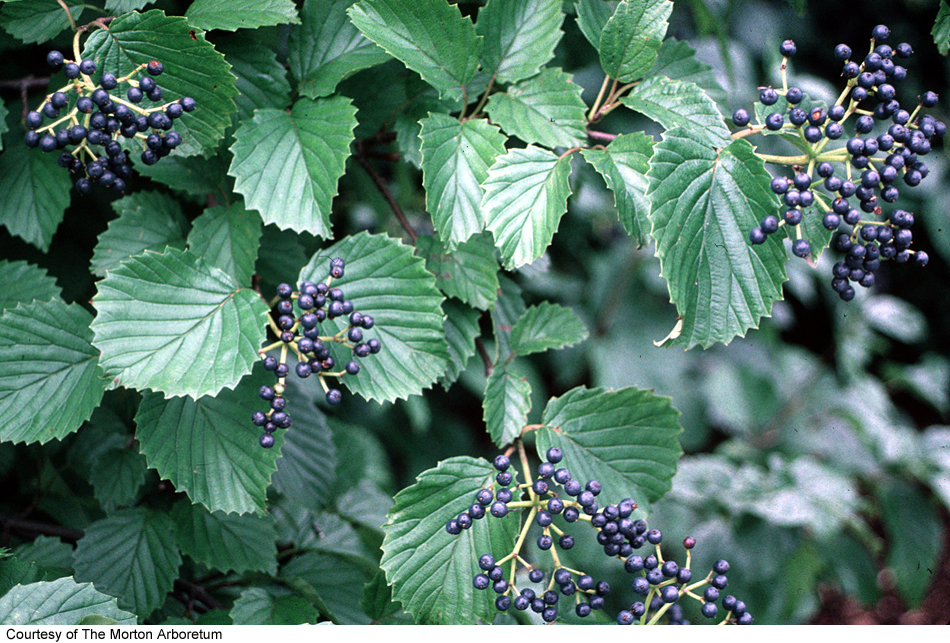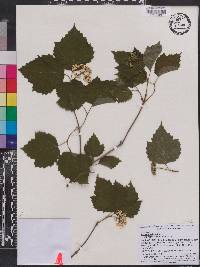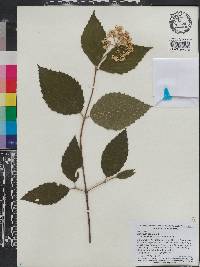|
|
|
|
Family: Adoxaceae
southern arrowwood
[Viburnum crenatum McAtee, moreViburnum dentatum var. scabrellum Torr. & A.Gray, Viburnum dentatum var. semitomentosum Michx., Viburnum pubescens (Ait.) Pursh, Viburnum scabrellum (Torr. & Gray) Chapman, Viburnum scabrellum var. dilutum McAtee, Viburnum semitomentosum (Michx.) Rehd.] |
Shrub 1 - 5 m tall Leaves: opposite, stalked, shiny green above, dull green beneath, 4 - 10 cm long, mostly rounded with a heart-shaped base (sometimes) and pointed to rounded tip, sharp-toothed, thick, bearing many star-shaped hairs on the lower surface, veins strongly raised. Leaf stalks 8 mm - 2.5 cm long, with star-shaped hairs. Flowers: in branched, compound clusters (cymes), which are borne terminally on the stems. Cymes mostly five- to seven-rayed, flat-topped, to about 13 cm wide. The leaves subtending the cymes have leaf stalks over 7 mm long. Corolla five-lobed, white, 4 - 5 mm wide, bell-shaped, sometimes sparsely hairy internally. Corolla tube to 1.2 mm long, 2 - 3 mm wide. Stamens five, exserted from the corolla. Anthers yellow. Stigma three-lobed. Fruit: berry-like (drupe), in clusters, bluish black, 5 - 10 mm wide, spherical, single-seeded. Twigs: slender, angled, downy when young, becoming hairless with age. Form: rounded with arching branches. Similar species: Two other varieties of Viburnum dentatumoccur in the Chicago Region: dentatum and lucidum. Variety dentatum differs by having egg-shaped, thin, and nearly hairless leaves. Variety lucidum differs by having nearly hairless leaves and hairless leaf stalks. Viburnum rafinesquianum is also similar but has stipules on the leaf stalks. Also, the leaves subtending the inflorescence of V. rafinesquianum have leaf stalks no longer than 7 mm. Flowering: May to June Habitat and ecology: Introduced from farther east. Our only Chicago Region record is from Cook County, Illinois. The plant was found growing in a woodland edge, and was probably an escape from cultivation. Occurence in the Chicago region: non-native Notes: About 200 species of Viburnum occur between North America, Europe and Asia. Many are ornamental shrubs cultivated for their showy flowers, autumn foliage, and attraction to wildlife. Etymology: Viburnum is the Latin word for the Wayfaring tree. Dentatum means toothed. Author: The Morton Arboretum Shrub 1-5 m, with close gray-brown or reddish bark; petioles 8-25 mm, glabrous or stellate, usually exstipulate; lvs lance-ovate to rotund, 4-10 cm, sharply acute or short-
acuminate to broadly rounded, sharply toothed; cyme mostly 5-7-rayed, the peduncle 3-6 cm; hypanthium glabrous, sparsely glandular, or setose; stylopodium pubescent; fr blue-black, subglobose to ovoid, 5-10 mm; stone ellipsoid, plump, deeply grooved on one side; 2n=36, 54, 72. Me. to Ill., s. to Fla. and Tex., and elsewhere as an escape from cult. May-July. Variable in morphology and habitat; divisible into several vars.: Gleason, Henry A. & Cronquist, Arthur J. 1991. Manual of vascular plants of northeastern United States and adjacent Canada. lxxv + 910 pp. ©The New York Botanical Garden. All rights reserved. Used by permission. |




